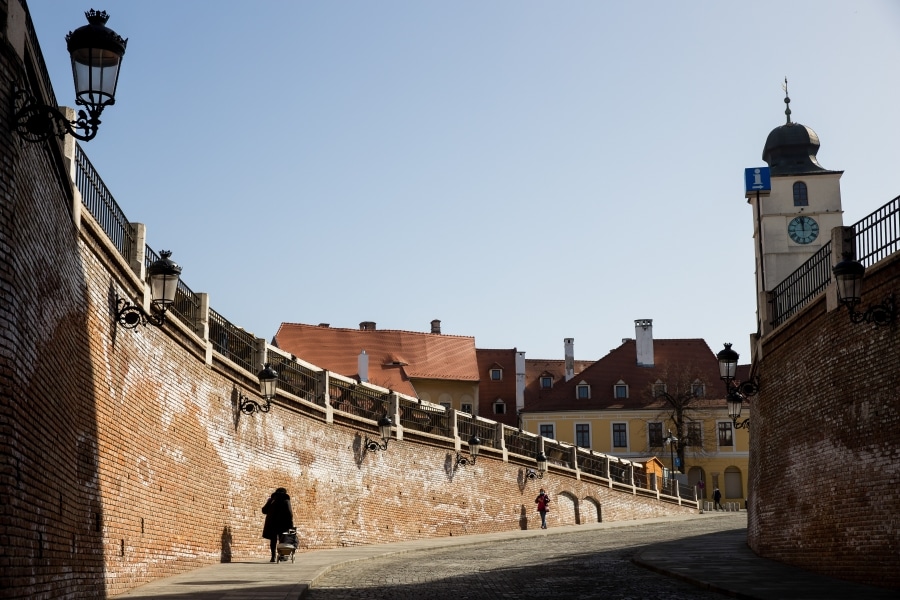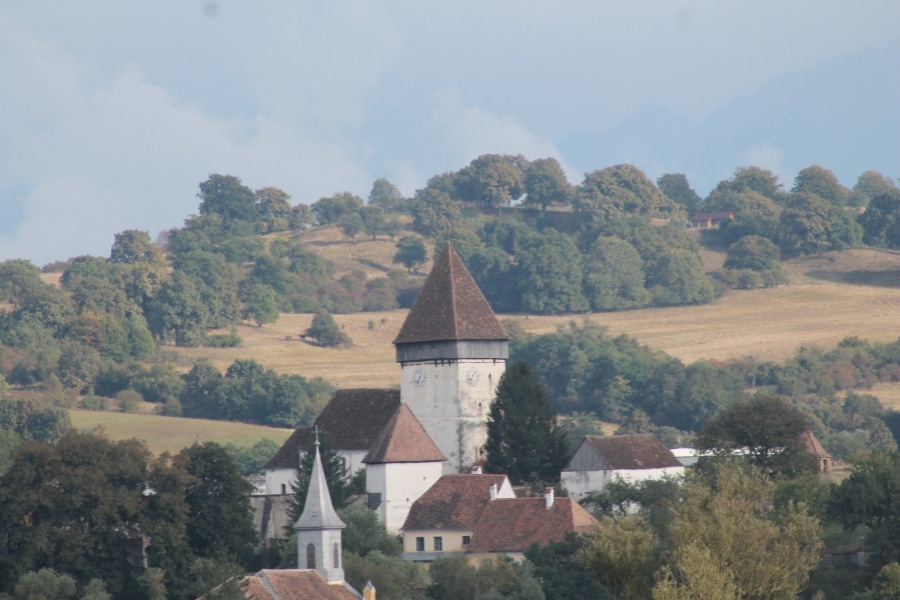We have been looking forward to this moment all winter – to arrive in Metis, (a Saxon village not far from Agnita) – we throw open the windows and shutters, sunlight and the freshness of spring take over the house instantly. This house was build by Saxons 200 years ago, with its thick stone walls, an arched cellar and a walled garden, situated in the upper corner of the village, hidden under two huge linden trees, as old as the house itself. From the house we look down through the foliage on the road passing the medieval church yard on the right to reach the junction between the old school and the village store. On the left side the saxon farmhouses stay aligned, tied to each other by high walls, wooden porches and tall oak barns. The village seems to float in a sea of green forested hills, just recently in leaf, every now and then the wind brings along a thin fragrance of accacia blossoms from the woods. During a sparse spare moment we walk up the hill at the back of the house – right above the sea of green, the horizon is drawn in chalk against the blue sky, winters last snow on the Făgăraș mountains.
Even though we have our small tourist business in the North of Romania, in Carlibaba - a six hours drive from here, in the Rodna Mountains, Metis is my favorite retreat. The house has been saved from any changes or modernities, the toilet is in the back of the garden, there is a deep well inside the house, next to a bread oven that fills the other half of the scullery. As you will understand there is still some work to do on the place, but it doesn’t scare me at all, nowhere I feel more motivated, I sing happily while I work all day. Its like I am closer to home in this part of Romania, this Saxon villages reminds me of the place where I grew up in Holland, occasionaly I get the chance to play an organ in one of the age-old Transsylvanian churches, and the echoes of the psalms that my hands still know sound strangely familiar.
In the morning, when I try to detach the hinges from the old oak windows to reuse them for the new ones, I start to think again about the last article I wrote for Republica.ro about Romanias potential for tourism, and why the expectations are never met. What I wrote about Romania as a whole, is found here in a condensed form. The former Saxon region of Siebenburgen is one of the most idyllic places in Europe if you ask me - the region could be easily compared with cultural tourist hotspots like the Cotswolds, the Dordogne or the Romantischer Strasse in middle Germany – if things were rightly managed, dont get me wrong. Especially the area surrounded by the medieval and well restored cities of Sibiu, Medias, Sighisioara and Brasov, roughly speaking, between the Tarnava and Olt rivers, with the lovely Hartibaciu valley in the middle, this area should be destined to become a historical reservation, a national medieval parc, „the heart of Transsylvania” or something similar. articol despre potențialul României ca destinație turistică și ce ne împiedică să atingem potențialul. Ce este valabil pentru România în general aici se găsește într-o forma condensată. Potențialul este enorm – după părerea mea fosta regiune Siebenburgen este una dintre cele mai idilice locuri în Europa, comparabil cu zonele precum Cotswolds în Anglia, Dordogne în Franța, sau strada Romantica în Germania. Mai ales zona încercuită de orașele medievale Sibiu, Mediaș, Sighișoara și Brasov, dintre Tarnava și Olt, cu valea Hartibaciului la mijloc, din partea mea ar trebui să fie schimbate pe loc într-o rezervație istorică, un parc național medieval – „inima Ardealului” , „the heart of Transylvania” sau ceva asemănător.
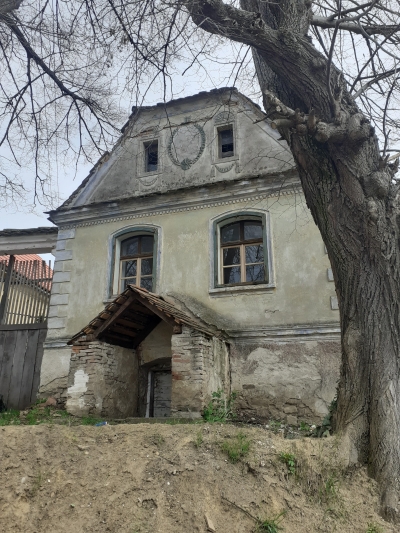
When my Dutch friends ask me what makes Romania worth a visit, I suggest to start in Sibiu. I tell them my stories about the utterly charming countryside decorated with numerous churches, walls and towers. About the villages with its ribbons of Saxon houses, woven together with barns and porches, walled gardens and cobble stone yards, lingering around the church-dwellings and the village school. Between the villages there are mansions, ruins of castles and hill-top strongholds, around every corner the view changes. Nature is still unspoiled, the hillsides still show the shape of terraces, remains of vineyards, hop-gardens and orchards. I show them pictures of our bike tours through the forest, small roads like a tunnel through the woods, then out in the open the wastelands with its herds of sheep and goats, watched by a sleepy dog, under an ancient tree a shepherd leaning on his stick, staring in the distance. All against the backdrop of the majestic Carpathian peaks, often covered with snow, either of the reclining winter, or of the approaching fall. Its hard to estimate the value of this region, untouched by modernism and as by a miracle saved from the destruction of the two world wars, but I dare to state that this region is the pearl of central Europe and would totally merit a special status for its conservation. To be administered for culturally interested tourists from all over the world, with traditional hospitality and local gastronomy.
So far about the potencial of the region, and to be honest, I cant say nothing is done, I have seen some wonderful private initiatives. Cincsor is a beautiful place, where a single family has changed the complete historical center into a holiday destination. The same applies for Veseud where a couple of Saxon farmhouses were turned into a peaceful pension, with a restaurant in a barn, and a rare view on the surrounding hills – and a total silence, at a campfire at night we only hear an owl’s cry. And this is exactly what the western tourist is looking for, stressed out by his job, the harrassment of modern city life, a few days to recover, reading a book, playing ball with the children, telling stories around the fire in the evening, a guitar song.

At the core of these Saxon villages’ beauty is their heritage, their fortified churches are the most famous obviously, but the villages are quite charming in themselves. The Saxons had a keen eye for how to create their villages, they used the natural relief, the course of the water, to locate the school, the workshop and the farmhouses around the central place in every village – the fortified church. A kind of Feng Shui avant la lettreThe form of the villages reflects the cohesion of its communities, still visible, though it doesn’t function anymore, since its population has changed drastically. To use the charms of ancient times for modern tourism means that we need to focus on the preservation and restoration of this heritage, and again another private initiative crosses my mind, the monument ambulance a group of volunteers that intervenes when a certain monument is on the brink of collapse, they try to rescue it. An admirible initiative, I wish them luck in all their efforts. Probably you observed that I have mentioned only private initiatives, so probably you ask yourself - what about the Romanian government
Well, in Romania the government is absent, on many issues, but in this case in the clearest way possible – absent, uncaring, indifferent. I can come to no other conclusion than that the government doesnt care – at all! And I dont want to talk about a castle falling into ruins, here or there, or a church, may God forbid it, no, this is something we got used to. I want to talk about structural flaws in the way the national heritage is handled by the government. I would like to explain it by using an anecdote. When I bought the house in Metis for a modest price, I started making plans for its restoration to include it in the tourist activities we already had. With a kind of a business plan which was partially based on - beside the use of some personal savings – a mortgage from the bank. This was the way I was used to work with a few monuments that we had restorated in The Netherlands, so why wouldnt this work in Romania? At our first meeting at the bank, we found out that the location of the house – Metis – made it impossible to apply for a mortgage. Why, I wanted to know. Well, just because of the postal code, not just Metis, but the whole area around it too. Kind of strange, I thought, but we continued to the next bank and another one, but I couldnt believe it, all the same, impossible to get financed on any real restate in this whole Saxon villages region. Maybe you wonder – what’s the government’s mistake in this, it’s the bank’s policy. Wrong answer! In a capitalist economic system the state has to make sure the parameters are set correctly. The rules of the game, the level playing field, equal rights for all that participate are attributions of the state. a level playing field, If banks can do what they want, if they can exclude whole groups or regions based on their profit expectations, it’s made too easy for them, this way everyone could make money. If the commercial banks have the right to exclude parts of the country, by denying access to the capital market based on a postal code, this whole areas development is practically blocked
If the bank states the value of real estate in a region is nil, I mean without bothering to make a real estimation on the ground, the capitalist system automatically confirms this estimation, that central is the role of the bank as the more or less sole provider of capital, if the bank would finance however little they would want to risk, the market immediately would react and take courage as well. For example – if the bank would have been taking the effort to come over to my house for an estimation, let’s say they would have estimated the value at 10.000, and grant me a mortgage of another 5000, with strict conditions, invoices, work reception, I would have been able to improve my house, thus creating added value again. And not only me, also my neighbours, together we would create jobs by restorating the national heritage. We could break the vicious circle of the villages depopulation and the degrading of the monuments. Maybe, I realize, I wouldn’t have been so upset if this story was about a far off village in the dry Moldovian fields somewhere, but we are talking about the heart of Transsylvania, this part of Romania with a huge potential for tourism. When you realize that this area is home to two ambitious European rulers (Klaus 1st and Charles 3rd) the question is raised, why is nobody paying attention to the details.
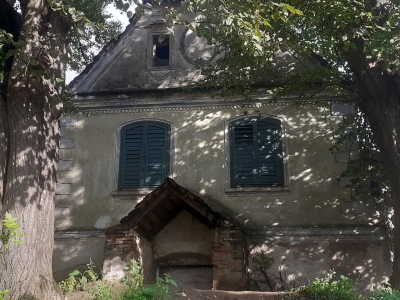
The second problem I would like to discuss is another flaw of the system, yet another anecdote may shed light on what is going on. Our road from Carlibaba to Metis leads through the village of Teaca, a Saxon village between Bistrita and Reghin. In this village two important monuments existed, the 14th century gothic church, and an abandoned house, more of a manor, opposite the village council. It was easy to recognize the importance of this house, a two store building with a typical late baroque roof type, and in the back yard the annexes, beautifully decorated with mid 19th century floral motives. We saw this house before we bought the one in Metis, we even stopped and asked around, talked to the mayor of the village about the opportunity to buy it, or to participate in restorating it. Well, the mayor and his men declared, its not that simple (it never is in Romania) A part of the house is ours, but in the back there are still living a few families, some of them legal inheritants of a small share of the house. But they promised to inform us, might any possibility arise. We waited, we called over and again, with every time we drove through the village the monument was clearly suffering, until recently I crossed the village to observe that nothing was left, the place was clean and empty, somebody poured a large concrete floor on top, just to be sure, I suppose. Well done, got rid of this old rubbish. I stopped to have a look at the church, another painfull proof of the total lack of interest, the doors were half open, one without hinges, kept together by a locked chain. When I looked inside I saw the church interior in total disarray, the ceiling fallen down on what has remained of the furniture, a building close to its collaps, only the craftsmanship of the old Saxon builders still keeps it standing, even for the village council’s bulldozer this would be quite a challenge. It didnt take long for me to be chased off by a dog I probably disturbed in its sleep, someone installed it here to keep an eye on the monument, or to complete the utter mess, and provide it with a hostile stenge. In the neighbouring hamlet Viile Tecii the situation is even worse, the Foldvari castle from 1753 and the evangelical Saxon church have vanished in thin air a few years ago.

Somehow I saved the day by visiting nearby Posmus. We became friends with a small group of skiers, that regularly come to Carlibaba, one of them is Mrs Veronica who told us about her job, leading a restoration project at the Teleki castle in Posmus. I knew the place, a few years ago I passed by, it was an awful sight, the castle totally lost its former splendour, it was a pretty gloomy place. So after the disappointment at Teaca I made a call, and took off for Posmus, not expecting too much. But to my surprise the transformation of the Teleki castle was way beyond my expectations. From the heaps of debris a proud building has arisen, from whatever direction you approach the village the distinguised castle captures your view. I got a tour through the building, and the gardens, under an impressive oak tree the guide told me all about the history of the place, to continue our tour to a small concert room with a piano, a wine cellar, an art exhibition – a real exemple of what can be done to include the Romanian heritage as an asset to attract domestic and international visitors.

Two important changes I would like to propose to the romanian government. First would be a review of the national heritage in the Saxon villages. The lists of national monuments are published on patrimoniul.ro, but a closer look shows something odd. It seems they sent a trainee to these Saxon villages, or an official without any passion for history at all, who just ticked in the forms – old church, yeah, let’s go on, next village. But when they checked off these churches they didn’t observe that everything around them is pure history, the whole villages centers are at least a hundred years old. Why there isn’t any house included in the list, not in Metis, not in Teaca, in many of the most interesting villages they didn’t include a house, a school, nothing whatsoever, but the church. So please, a new list, as fast as possible, as detailed and complete as possible. Because time is ticking. UNESCO has a different approach, their heritage list includes 7 Saxon villages as a whole, recognizing the value of the ensemble. This would be a constructive method for the national heritage lists also, the villages to be included with most of its building altogether. From there on, it would be a small step to recognize the whole area as a monument, to grand it a special status for its conservation.
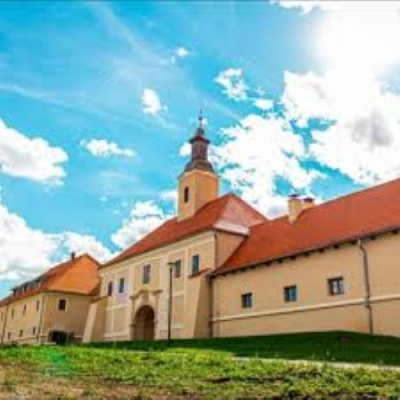
The second change I would like to propose is to finally take some attitude in the protection of the Saxon heritage. Decisions regarding local monuments can’t be left in the hands of local politicians, they don’t have the necessary education to handle such a delicat subject. Its like moving the porcelain collection of the museum by local school boys, you can’t expect that to end well. So, to cut it short, the heritage needs to be classified again, and then administered, maintained, controlled and sanctioned actively, with a clear view and the right knowlegde.
Some might ask – why bother about these Saxon villages, we live in Romania now, the Saxons have left, the Hungarians too, so why bother. Well, why didn’t the Turks take down the Hagia Sofia, or the Spanish the Alhambra after the Reconquista – right, as a sign of their dignity, their civilization and their tolerance. Adding to their glory the cultural remains of their opponents. I consider that with the Saxon heritage Romania received a precious jewel, the fact that it doesn’t write made in Romania on it, doesn’t make the responsibility any less, I would say - on the contrary. We now live in the European Union, the borders are clearly drawn and stable, nobody is making any claim – as Transsylvania is the most multicultural part of Romania we better use it as an asset.
Because, and I conclude by repeating my dream about this national historical parc – the heart of Transsylvania: if the Romanian government would create these two basic conditions – a revisited list of the Saxon heritage and access to finance for the maintainance of it, the situation might change. For I believe that we can attract all who where once involved in the history of this area to participate in the resurrection of it – the Germans could do better in preserving their villages if they trusted the Romanian politics, the Hungarians still own a lot of mansions, manors and other properties that could be saved by including them in its restoration. Also the Jewish heritage needs attention, I only think of the beautiful synagoge in Medias, the Armenians need to be addressed about Dumbraveni, a baroque city right at the gate to the parc. The Roma people have many skilled workers, who could be specialized in restoration, improving their own situation and possibly improving their houses at the margins of the Saxon villages. So in the end, I would propose to make this project a real pan-European enterprise, a proof or maybe to put it in a safer way, a pilot-project of a shared culture and a constructive brotherhood between former rival nations.

